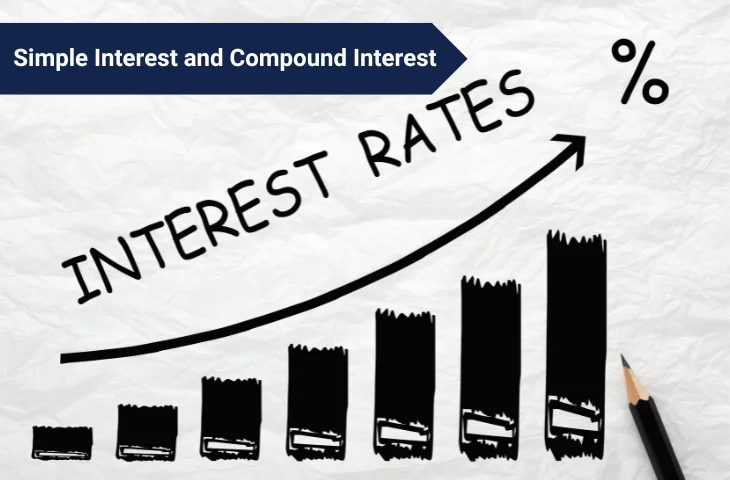Simple Interest and Compound Interest are two of the most common financial math topics tested in Quantitative Aptitude sections of SSC, Banking, and other competitive exams. These questions often test your ability to calculate interest amounts, principal, time, or rate using either direct formula or logical shortcuts. In this we have provided the definitions, formulas, question types, smart tricks, and provide memory-based solved examples from 2024–25 exams.
What Is Simple Interest and Compound Interest in Quantitative Aptitude?
Simple Interest (SI) is the interest calculated only on the original principal for a specific period of time.
Compound Interest (CI) is calculated on the principal and also on the accumulated interest from previous periods.
These concepts appear frequently in exams because they test your understanding of percentage, ratio, and formula application.
Skills Required:
- Basic percentage calculation
- Application of formulas
- Time-value understanding
- Logical thinking for compound interest intervals
What is the Difference Between Simple Interest and Compound Interest?
Understanding the core difference between Simple Interest (SI) and Compound Interest (CI) is essential for choosing the right formula while solving the questions.
| Feature | Simple Interest (SI) | Compound Interest (CI) |
| Basis of Interest | Calculated only on the principal | Calculated on principal + previously earned interest |
| Formula | SI = (P × R × T) / 100 | CI = P × (1 + R/100)^T – P |
| Interest Amount | Remains same every year | Increases every year due to compounding |
| Compounding Frequency | Not applicable | Can be annually, semi-annually, quarterly, etc. |
| Use in Exams | Mostly direct and formula-based | Frequently appears with twist on frequency or time |
| Real-Life Application | Useful in short-term loans, fixed deposits | Used in investments, savings accounts, business growth |
Why Is Simple Interest and Compound Interest Important in Competitive Exams?
Simple and Compound Interest questions frequently appear in almost every major competitive exam. They are considered scoring if you understand the core formulas and apply shortcuts.
| Exam | No. of Questions | Difficulty |
| SSC CGL / CHSL | 1–2 | Easy |
| IBPS PO / SBI PO | 1–2 | Moderate |
| RRB NTPC / Group D | 1 | Easy |
| State PSC / Police | 1–2 | Moderate |
Simple Interest and Compound Interest Quantitative Aptitude Short Notes
Some of the commonly used terms in simple and compound interest are as follows:
| Term | Meaning |
| Principal (P) | The original amount of money invested or borrowed |
| Rate of Interest (R) | The percentage at which interest is calculated annually |
| Time (T) | Duration in years for which the money is invested/borrowed |
| Simple Interest (SI) | Interest on principal only |
| Compound Interest (CI) | Interest on principal + accumulated interest |
| Compounding Frequency | Number of times CI is calculated per year (annually, semi-annually etc.) |
| Amount (A) | Total money = Principal + Interest |
Simple Interest and Compound Interest Concepts
Some of the common concepts of Simple and Compound Interest are as follows:
| Concept | Explanation |
| SI Formula | SI = (P × R × T) / 100 |
| CI Formula (Annual) | A = P × (1 + R/100)^T, CI = A – P |
| Difference CI – SI (2 yr) | CI – SI = P × (R/100)^2 |
| CI (Half-yearly) | A = P × (1 + R/200)^(2T) |
| CI (Quarterly) | A = P × (1 + R/400)^(4T) |
| Doubling Time (CI) | T = log(2) / log(1 + R/100) |
What Are the Types of Simple Interest and Compound Interest Questions in Quantitative Aptitude?
Competitive exams test SI/CI concepts in various formats:
- Direct Formula-Based – Plug values into SI or CI formula
- Difference-based – Find difference between SI and CI
- Time/Rate/Principal Missing – Find the unknown variable
- Compounding Frequency Based – CI problems with semi-annual/quarterly compounding
- Combined Concept Questions – Clubbed with Ratio, Percentage, or Profit-Loss concepts
Simple Interest and Compound Interest Formulas for Quantitative Aptitude
The core formulas of the SI and CI are as follows:
Simple Interest Formulas:
- SI = (P × R × T) / 100
- A = P + SI
Compound Interest Formulas:
- A = P × (1 + R/100)^T
- CI = A – P
- If CI is compounded half-yearly:
A = P × (1 + R/200)^(2T) - If compounded quarterly:
A = P × (1 + R/400)^(4T) - CI – SI for 2 years = P × (R/100)^2
Simple Interest and Compound Interest Tricks for SSC CGL and Other Exams
Tricks most commonly used for the SI and CI questions are as follows:
- Learn percentage equivalents (e.g., 5% = 1/20) to avoid decimal multiplications
- For 2 years, directly use CI – SI difference formula
- If amount becomes double/triple, use log or try options smartly
- Use alligation if two rates/times are mixed
- Use reverse calculation if final amount is known
- Apply successive interest rule: A = P(1 + x/100)(1 + y/100) for 2 years
Solved Simple Interest and Compound Interest Questions from 2024–25 Exams
Q1. (SSC CGL 2024 Tier 1 – Shift 2)
The simple interest on ₹10,000 for 3 years at 6% p.a. is?
- Answer: ₹1,800
- Explanation: SI = (10000 × 6 × 3)/100 = ₹1,800
Q2. (IBPS PO Prelims 2024 – Memory Based)
Find the compound interest on ₹8,000 for 2 years at 10% p.a., compounded annually.
- Answer: ₹1,680
- Explanation:
A = 8000 × (1 + 10/100)^2 = 8000 × 1.21 = ₹9680
CI = 9680 – 8000 = ₹1680
Q3. (RRB NTPC 2024 – Based on memory)
The CI on a sum for 2 years is ₹512 and SI is ₹500. Find the principal.
- Answer: ₹10,000
- Explanation: CI – SI = P × (R/100)^2
12 = P × (R/100)^2
Try R = 10%, ⇒ (10/100)^2 = 1/100
⇒ P = 12 × 100 = ₹1,200 (Mismatch)
Try R = 8%, ⇒ (8/100)^2 = 64/10000 ⇒ P = 12 × 10000 / 64 = ₹1,875 (Mismatch)
Try R = 5%, ⇒ 25/10000 ⇒ P = ₹4800 (Still off)
⇒ Best done with options (in actual exam)
Simple Interest and Compound Interest Concepts for Bank Exams
In IBPS or SBI exams, CI problems are often combined with data interpretation or ratio questions. One frequent pattern is difference of CI and SI over 2–3 years or quarterly compounding.
Example:
Q. A sum of ₹5,000 is invested at 10% p.a. compounded half-yearly. Find the CI after 1 year.
- A = 5000 × (1 + 10/200)^2 = 5000 × (1.05)^2 = 5000 × 1.1025 = ₹5,512.5
- CI = 5512.5 – 5000 = ₹512.5
Common Mistakes to Avoid while Solving Simple Interest and Compound Interest
Common mistakes that must be avoided by aspirants while solving this topic are as follows:
- Using SI formula for CI – Always check if interest is simple or compound
- Missing compounding frequency – Read “half-yearly” or “quarterly” carefully
- Wrong power in CI formula – Use correct T and R depending on frequency
- Neglecting CI – SI difference tricks – For 2 years, this saves time
- Not checking units – Watch out for months vs years in time conversion
FAQs
Use: SI = (P × R × T) / 100, where
P = Principal, R = Rate %, T = Time (in years).
Use:
Doubling Time: T = log(2) / log(1 + R/100)
Yes. In Tier 2, these appear in arithmetic sections.
In SBI PO Mains, CI questions are often embedded in Data Interpretation sets.
For easy SI questions: Use formula.
For complex CI or multi-year questions: Try options first, especially if time is tight.
Use: A = P × (1 + R/100)^T for annual compounding.
Memorize values like:
(1.1)^2 = 1.21, (1.05)^2 = 1.1025, etc. to avoid calculator use in mock tests.
- BOI Apprentice Salary 2025, Check Stipend Details
- Upcoming Bank Exams 2026: SBI, IBPS, IBPS RRBs, Insurance Exams
- Bank of India Credit Officer Syllabus 2025, Check Exam Pattern
- Punjab and Sind Bank LBO Interview Result 2025 Out, Download PDF
- SSC CGL Tier 2 Previous Year Paper, Download Free PDF
- SSC CGL 2025 Tier 1 Question Papers, Shift-Wise PYPs, Download PDFs

Hi, I’m Aditi. I work as a Content Writer at Oliveboard, where I have been simplifying exam-related content for the past 4 years. I create clear and easy-to-understand guides for JAIIB, CAIIB, and UGC exams. My work includes breaking down notifications, admit cards, and exam updates, as well as preparing study plans and subject-wise strategies.
My goal is to support working professionals in managing their exam preparation alongside a full-time job and to help them achieve career growth.
